Red Kalinka
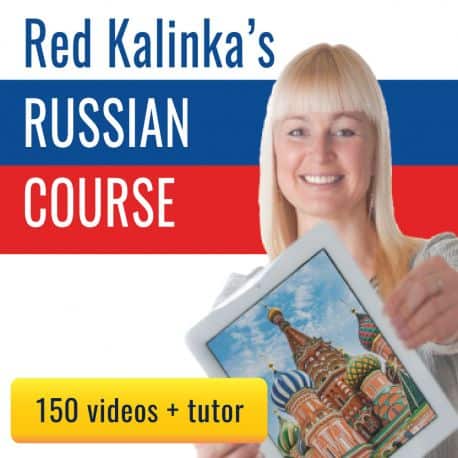
Summary
The ‘Largest Russian School in the World’, Red Kalinka has lots of different products that will get you learning Russian. Its main course – Sistema Kalinka – is very well thought out and will certainly improve the reading, writing and comprehension skills of beginners and intermediate learners. While it may not be the most entertaining thing in the world, the videos and exercises are exceptionally thorough. Your Russian will almost undoubtedly improve if you stick to this course.
The Sistema Kalinka videos and exercises might not be that innovative or entertaining, but you’ll learn a ton.
Sistema Kalinka goes into a lot of depth when it comes to vocabulary, grammar, and cultural explanations – possibly too in-depth!
It’s not the cheapest course you’ll find, but it’s worth the cost.
I Like
- Right from the start, you are encouraged to read, write and listen to Russian.
- The lessons all build upon each other, and I imagine it would be very motivating to progress to lessons that are conducted almost solely in Russian.
- Reading and writing aren’t neglected as they are with some other Russian language platforms.
- It’s easily the most comprehensive online Russian course I’ve tried.
I Don’t Like
- As all of the lessons follow the same format and go into such great depth, it can get a bit monotonous and boring.
- The exercises aren’t very exciting to work through and could all likely be found in any run-of-the-mill textbook.
Price
The Sistema Kalinka Russian Course costs 29 euros a month. Through the link below, however, you can save 20% on the subscription cost each month, making it only 23 euros per month.
They also have a bunch of different products such as audiobooks, one-to-one lessons and online exercises for you to sign up for.
At All Language Resources, we’ve tried tons of different resources for learning Russian. As we’ve often found, the best course for learning any language is rarely the most well-known.
For learning Russian online, that course is called Red Kalinka.
However, my first impression wasn’t especially positive.
Upon landing on their homepage, I felt overwhelmed with the numerous products and overall cluttered feeling. It even took me a while to figure out where and how to access the course.
What it lacks in flashiness it makes up for in high-quality, in-depth, and well-structured content.
That’s not to say it’s a perfect course — it’s not — but it’s the best Russian course I’ve come across.
It isn’t especially fun or exciting, but the quick progress you’ll make can help with that. If you’re serious about learning Russian and willing to put in the work, there’s no course that does as good of a job as Sistema Kalinka.
Although Red Kalinka has lots of other products for learning Russian, such as books, exercises, and lessons over Skype, this review will focus on its main Russian course.
Course Overview
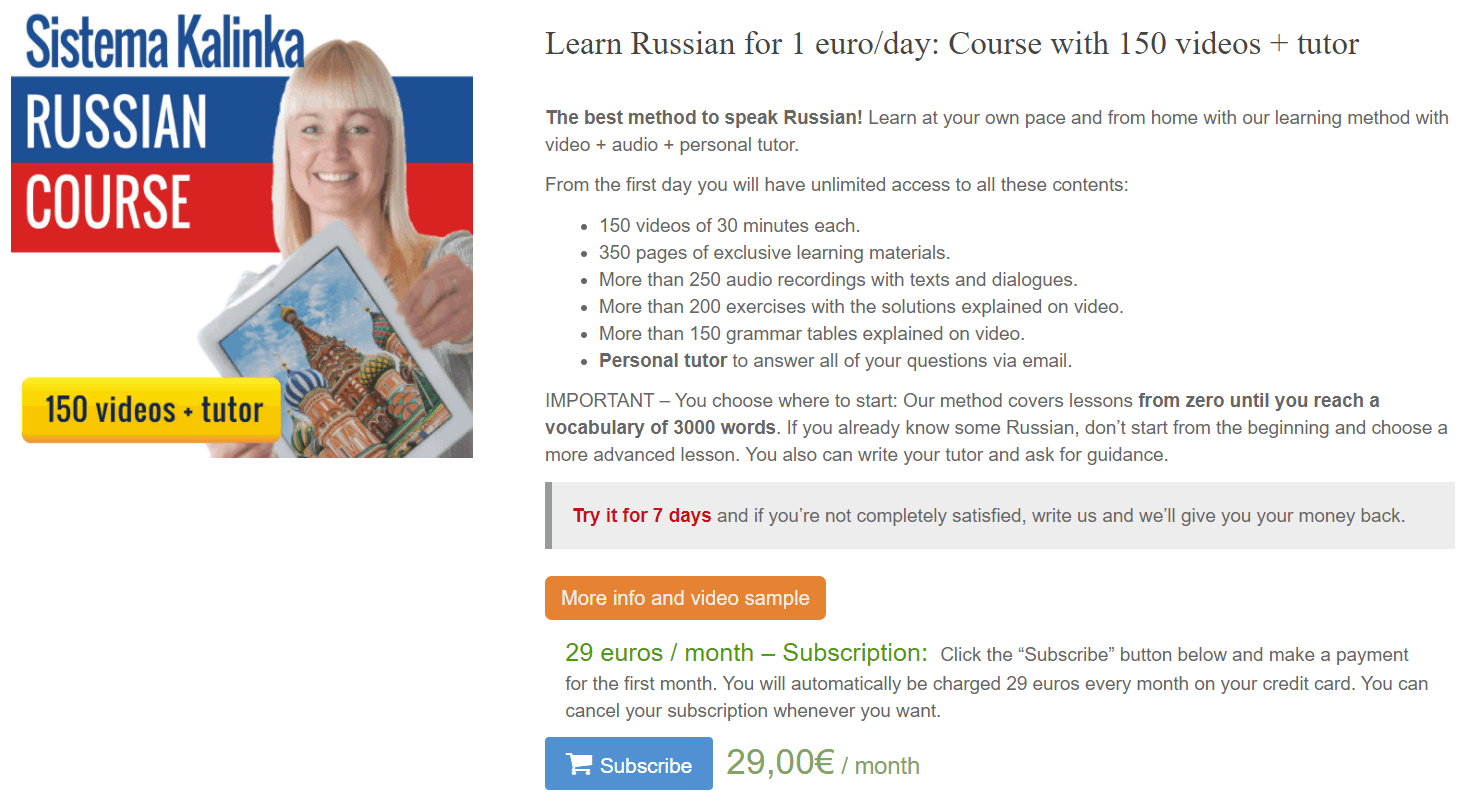
Red Kalinka’s Russian Course is appropriate for anyone from the absolute beginner to upper-intermediate level.
In the course, you’ll find 160 videos, 400 pages of learning materials, 250 audio recordings, hundreds of exercises, and more. In order to complete the entire course, the estimated study time is over 400 hours.
That’s a ton of content for you to work through – and all of it is well done. In terms of comprehensive content, I think every other Russian course pales in comparison to Sistema Kalinka.
Better still, you’ll also have email access to a personal tutor who can answer any questions you may have about the material.
After completing the entire course, you’ll know over 3000 words, be able to communicate and express yourself in most situations, as well as be able to enjoy watching Russian TV or reading newspapers.
The course is divided into four different stages, each with ten lessons, for a total of 40 lessons.
Lessons typically contain three or four parts, with each taking around thirty minutes to complete.
Over the duration of the course, you’ll get to read, listen to and watch Russian spoken in natural contexts by native speakers.
If you stick with Sistema Kalinka, your Russian will become pretty damn good.
Save 20% each month on a subscription to Sistema Kalinka by signing up through the link below.
Getting Started at the Beginning
Now, let’s go through the Russian Course, taking a closer look at what the lessons are like.

As Red Kalinka tells you straight away, if you already know some Russian, then you can always skip ahead in the course.
The lessons are clearly labeled as they tell you what vocabulary and grammar points each of them covers. So it shouldn’t be too hard to find a more appropriate one if the absolute beginner lessons are too easy.
Lesson 0: The Russian Alphabet
If you are just starting off learning Russian, then you’ll want to start with Lesson 0: The Russian Alphabet.
In this lesson, you’ll learn the Russian alphabet, what each letter sounds like, how to say them yourself and also read your first words in the language.
To achieve this, you have three videos to watch (each of them around half-an-hour in length) and a ten-minute audio file to listen to which complements the lesson PDF.
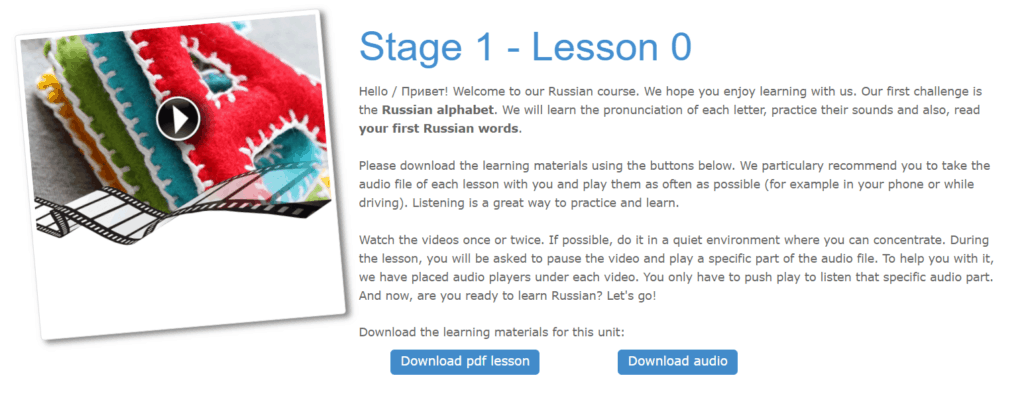
After clicking on the first video, you are greeted by your teacher who immediately tells you a little about the Russian alphabet, explaining that it uses the Cyrillic script and has 33 letters.
This mirrors what is said in the PDF and she brings it up on the screen when introducing us to our first word in Russian: Da or ‘Yes’.
After encouraging us to try and focus on the Cyrillic letter and associate each one with a sound in English, the teacher then tells us how to say ‘No’, stressing the appropriate pronunciation when necessary.
She does all this in a very friendly, engaging, and encouraging manner.
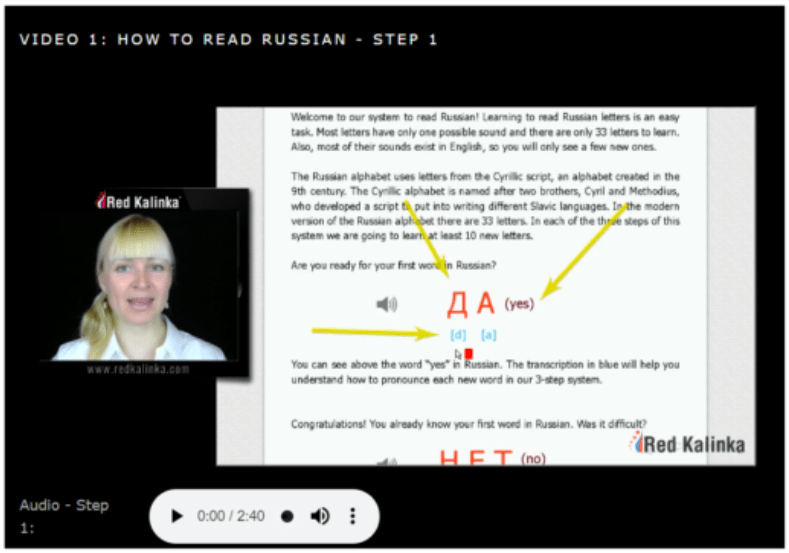
After this comes page 3 of the PDF where, remarkably, the teacher tells us that we have already learned five letters of the Russian alphabet just through learning ‘Yes’ and ‘No’!
I was pretty impressed at this, and it did make me feel like the Cyrillic alphabet was maybe not as hard to learn as I had imagined.
At this point, you’re meant to pause the video and listen to the audio file that you downloaded at the beginning of the lesson. You’ll listen to the various ways that the different letters can be said in different combinations with the other ones you’ve already gone over.
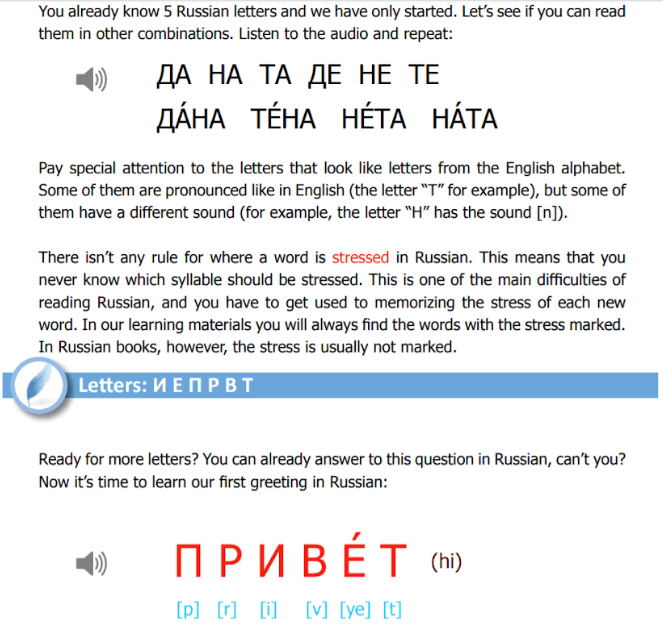
Once you’ve done this you return to the video where your teacher then goes through the different combinations with you so that you can hear how they are pronounced again and check that you remembered them correctly.
After having gone through the combinations we then learn how to say ‘hi’ (privyet) in Russian, and this introduces us to some new letters which include p, r, i and v.
We now know nine Russian letters after having only gone over three short and simple words in less than fifteen minutes!
On page four, we are introduced to another couple of letters (k and l) as we learn how to ask ‘How are you?’ and this is followed by page five of the PDF which has the first exercise for us to complete.
Here we need to listen attentively to the audio once more and fill in the missing words. We should be able to do this because we have already gone over these letters in the lesson.
While you may never have written Cyrillic before, you can simply imitate the shapes of the letters already covered in the class, matching them to the sounds in the audio.
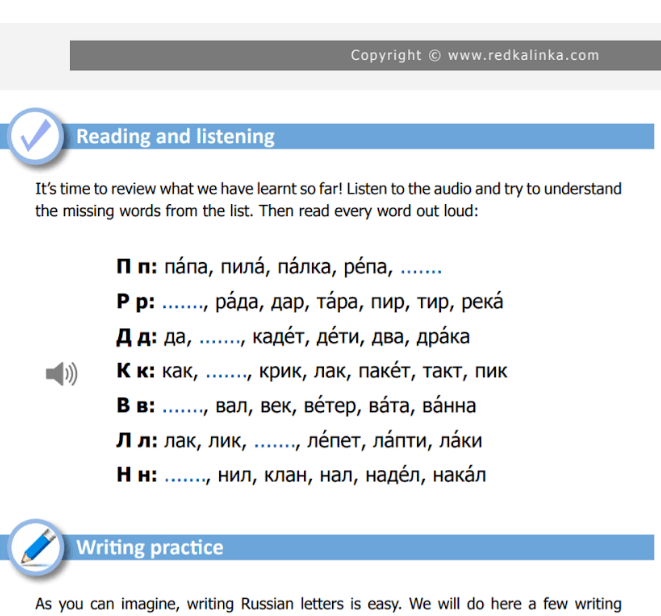
After this, the teacher goes through the exercises in a very clear and concise manner, pronouncing all the words for us and filling in the correct word in each line.
The final task for us is to practice writing some of the letters, simply repeating them over and over again, kind of likes kids in school do.
This takes us to the end of Step 1 in which we’ve learned a third of the Russian alphabet, how to say ‘yes’, ‘no’, ‘hello’ and ‘How are you?’ in just under half-an-hour.
Both Step 2 and 3 follow in a similar vein, this time focusing on stressed and unstressed letters and special Russian sounds, respectively.
The teacher again guides you through the PDF teaching new words and letters as we go and explaining Russian pronunciation.
The exercises are very similar in nature to the ones we have just seen and so we get to read, write, listen and pronounce the letters and words we come across, alternating between the video lesson, PDF and audio file while a final test at the end shows how much we have learned.
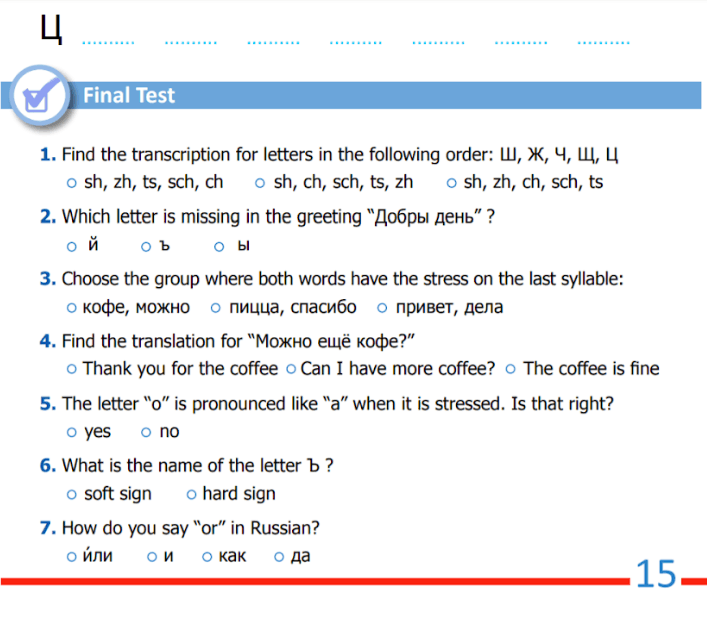
Save 20% each month on a subscription to Red Kalinka by signing up through the link below.
A Close Look at Lesson 1
While I thought that Lesson 0 was quite effective in teaching the Russian alphabet and found the exercises to be a helpful way to practice, I didn’t find it to be all that fun to work through.
This was despite the teacher being very encouraging and explaining things in a clear and concise manner.
As such, I was interested to see what Lesson 1 looked like and whether later lessons progressed much in difficulty or varied in terms of their content.
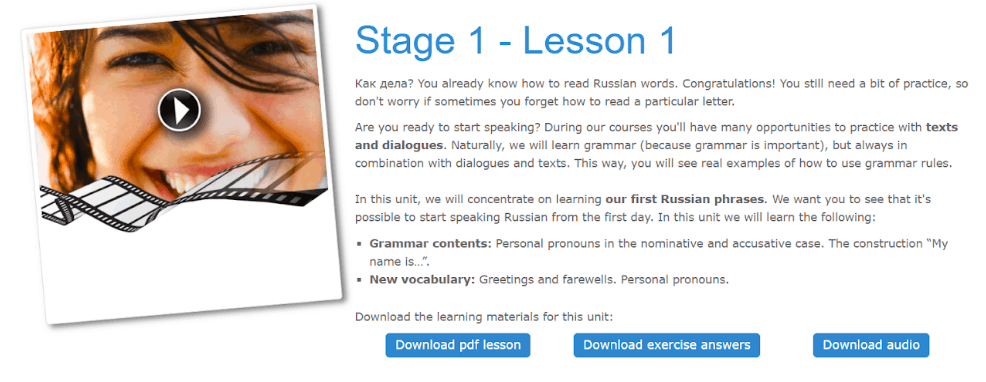
Focusing on getting you speaking and reading Russian right from the very beginning, Lesson 1 again has a video for you to watch and an audio file for you to download. It already represents a serious step up from the Russian alphabet lesson as absolutely every word in the PDF is written in the Cyrillic alphabet.
After clicking on the video which forms the main basis of the lesson, you are again greeted by our smiley friendly teacher who takes us through the PDF, explaining the various sections and what we can expect from the course ahead of us.
Vocabulary
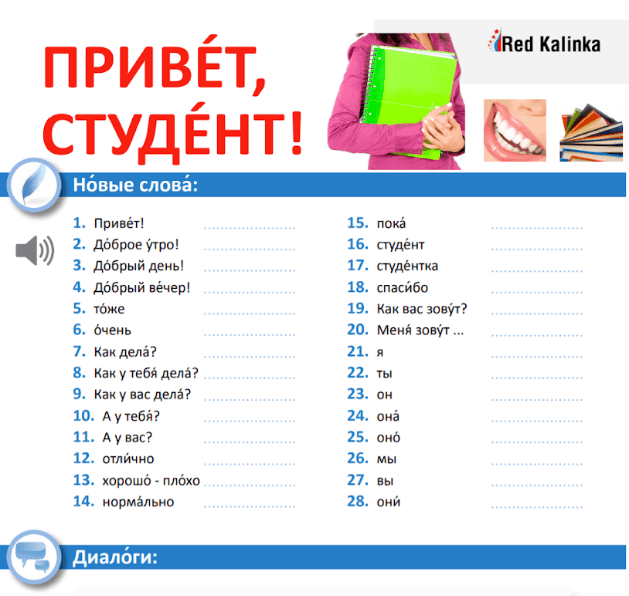
First up is the vocabulary section. Our teacher takes us through the list, pronouncing each one for us a couple of times and explaining how the words are used in their cultural context as well as any grammar points that come up.
While it is certainly very in-depth and covers a lot of essential vocabulary, it isn’t the most inspiring thing ever and it does start to drag on towards the end, taking twenty-five minutes in total to go through all of the words.
It is then recommended that you go through the vocabulary list again with the audio file, listening to how the words are pronounced and hopefully memorizing them in the process. It probably wouldn’t be a bad idea to review these words with Anki.
Grammar
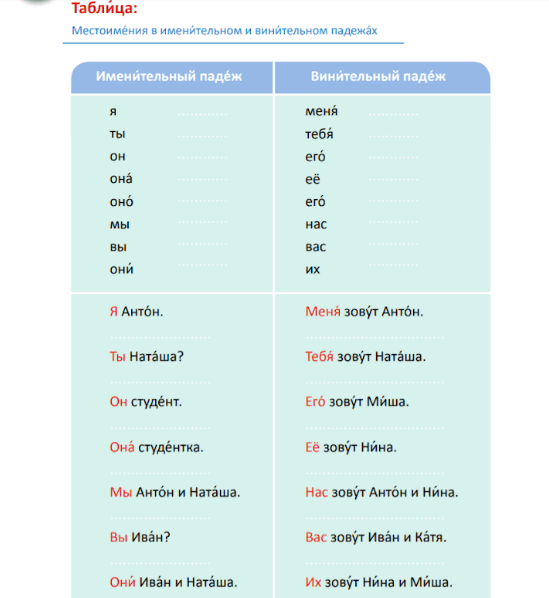
Next up is the grammar section on page four of the PDF. Again, everything is written solely in Russian – you are not even given the title of the table ‘Pronouns in the Nominative and Accusative Cases’.
While I admire the fact that they get you reading Russian so quickly, I do think that some English translations would have been helpful from time to time as otherwise you can get a bit bogged down slowly translating each section every time.
Instead, it is up to the teacher to take us through the table, reading each word out aloud for us to hear how it’s pronounced before going on to translate it into English so that we can actually follow what’s going on.
Although it’s very useful hearing the explanations about the various grammar points, it does get a bit tedious as the class basically amounts to the teacher reading through a PDF with us.
After completing this forty-minute video that explains all of the vocabulary and grammar points, there’s a small audio file below it which allows you to hear how all of the words are pronounced.
Dialogue
Following this is the Dialogue section, where we have eight dialogues as well as a video that explains them all.
This is where we finally get to hear our first conversations in Russian, and we should now be able to understand them all as we have already gone through all of the vocabulary and grammar used in them.
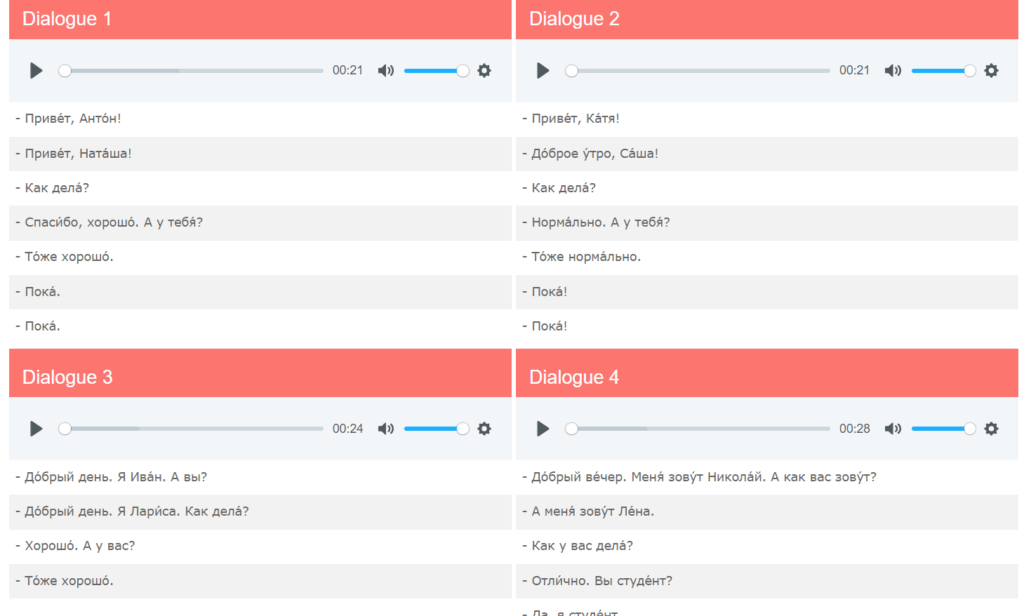
After we listen to the dialogues and try and understand what is going on in them, we again return to the main video where our teacher then explains various grammar points that arise in them as well as the cultural context in which they take place.
All in all, it takes another twenty minutes to go through the eight dialogues, and the teacher really does give a thorough analysis of absolutely everything. While I appreciated just how in-depth she was in terms of explaining the words, phrases and grammar points, it again wasn’t the most riveting thing ever.
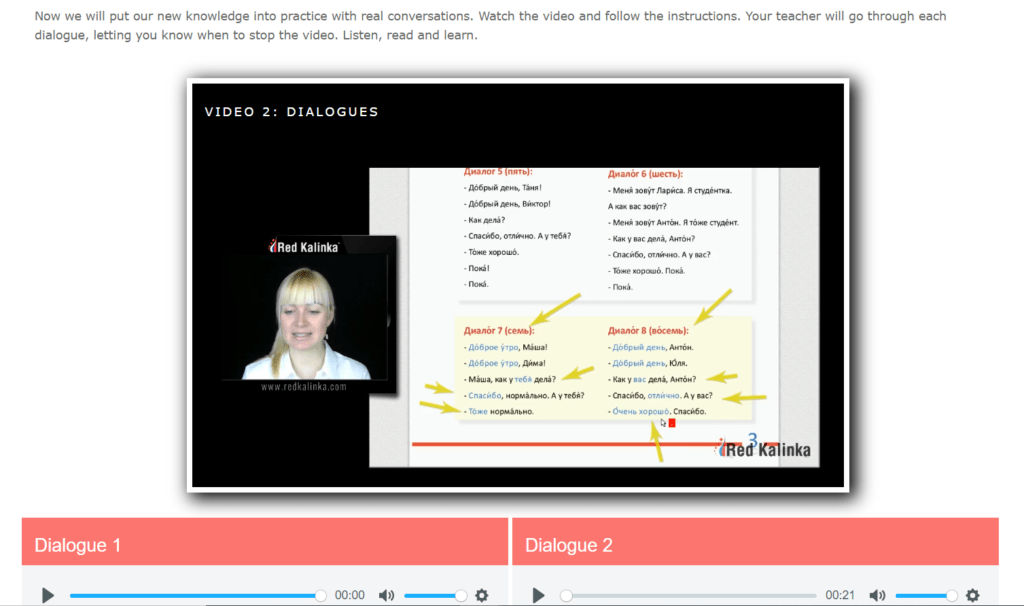
Exercises
The last part of the lesson consists of another twenty-minute video entitled ‘Exercises’ in which, well, you do various exercises.
These include a fill-in-the-missing-words exercise, an exercise where you change the phrases and conjugate some verbs, a fill-in dialogue where you answer with words that could be appropriate and a missing letters exercise.
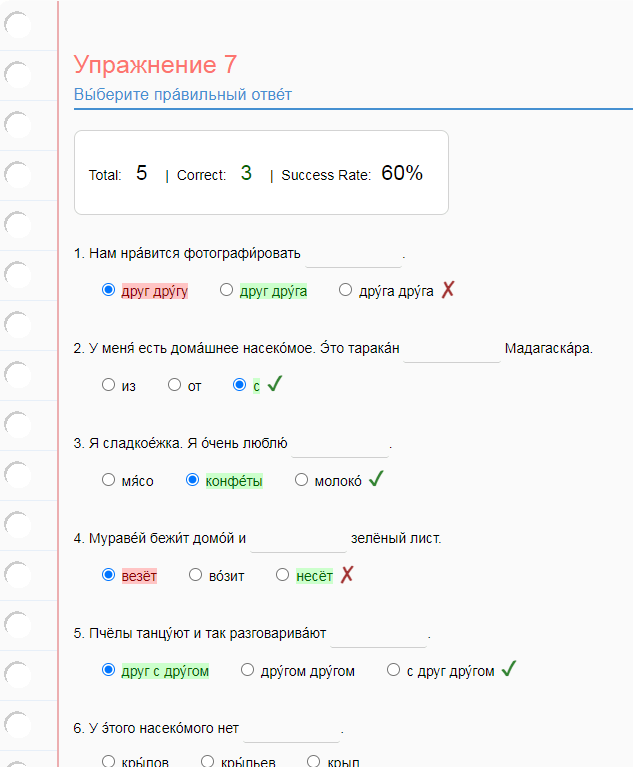
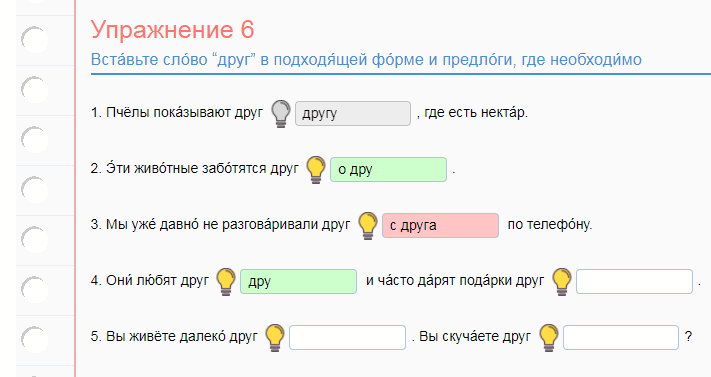
You’ll get immediate feedback on whether your answers are correct as you type them into the answer fields, and you can select the lightbulb to to reveal a letter in the answer if you’re having trouble.
After working through them on your own, the teacher takes you through all of the exercises, giving you the correct answers and explaining any complicated grammar points that arise.
The video ends with her quickly going over all of the vocabulary that we’ve come across in the class.
While the exercises, in general, are quite uninspiring and pretty much amount to those that you’d find in a textbook, I did find them to be useful, and the method for completing them on the computer is smooth and seamless.
It’s also pretty amazing that after your first proper lesson you’re already reading and writing in Russian.
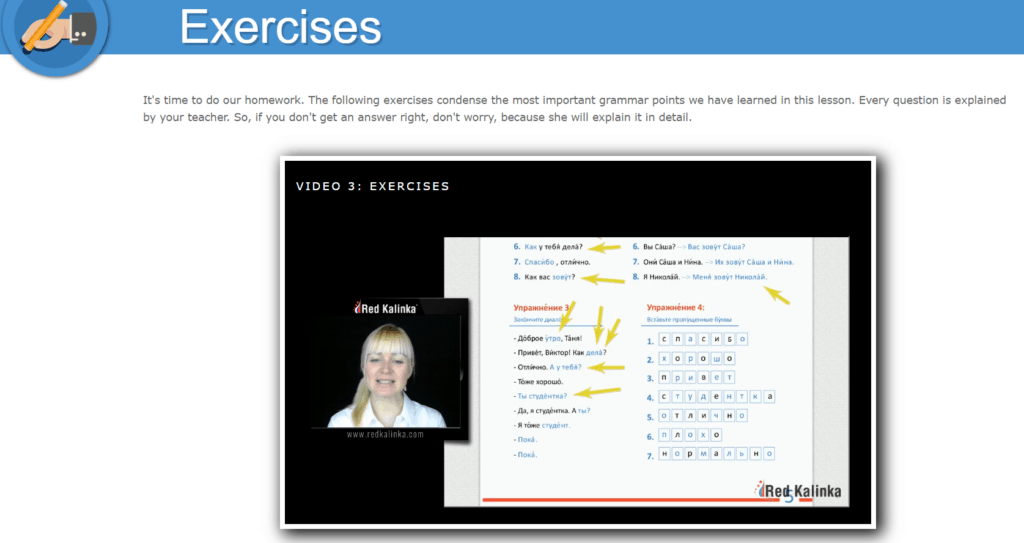
I came away very impressed by just how much you learn in both Lesson 0 and Lesson 1. You really are encouraged to read, write, listen and speak as much Russian as possible, right from the start.
It is undeniably effective as a method though and the teacher definitely goes into a lot of depth, analyzing and explaining both the vocabulary and grammar points that come up.
Now let’s take a look at some of the later lessons and see what Sistema Kalinka does well and where improvements could be made.
Save 20% each month on a subscription to Sistema Kalinka by signing up through the link below.
Later Lessons
After scrolling through a few of the lessons in each of the four stages, I could immediately see that the format remains the same throughout the course. The only difference in the later lessons is a text fully in Russian for you to read and analyze alongside your teacher.
This was a bit disappointing to see as I think the course could really do with a bit more variation. This, however, isn’t a complaint unique to Sistema Kalinka as nearly every language learning course I’ve tried has this same weakness.
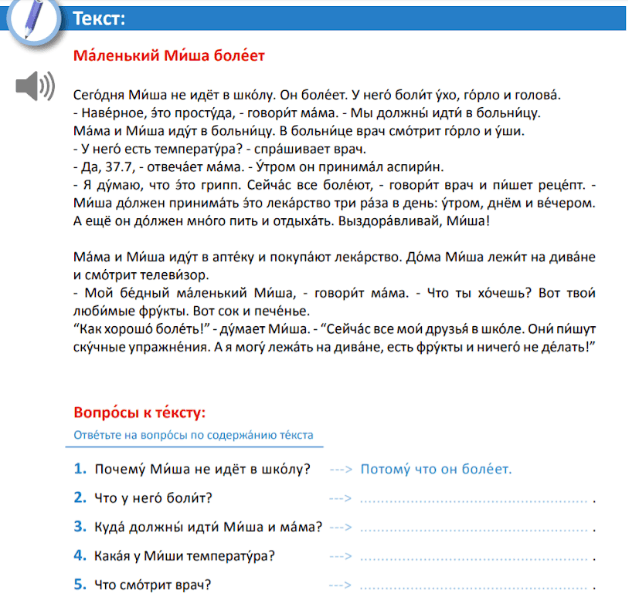
In essence, every lesson follows the same format…
- Introduction to vocabulary and grammar (30-minute video)
- Encouraged to review in your own time
- Go through dialogues with the teacher (30-minute video)
- Read through a text on the same subject (30-minute video)
- Work through various exercises from the attached PDF (30-minute video)
If you were to stick with Sistema Kalinka, you would certainly learn a hell of a lot. As you progress through the course, the later lessons are almost solely conducted in Russian.
I was really impressed with just how much Russian was used in the PDFs, the audio files and all of the videos. This is in stark contrast to a resource like RussianPod101, which, while useful, tends to use too much English.
The lessons in the Sistema Kalinka course build upon each other exceptionally well.
Working through the lessons would be quite motivating to see your progress. You really learn pretty much everything you could hope to from a course and your Russian skills will reflect that.
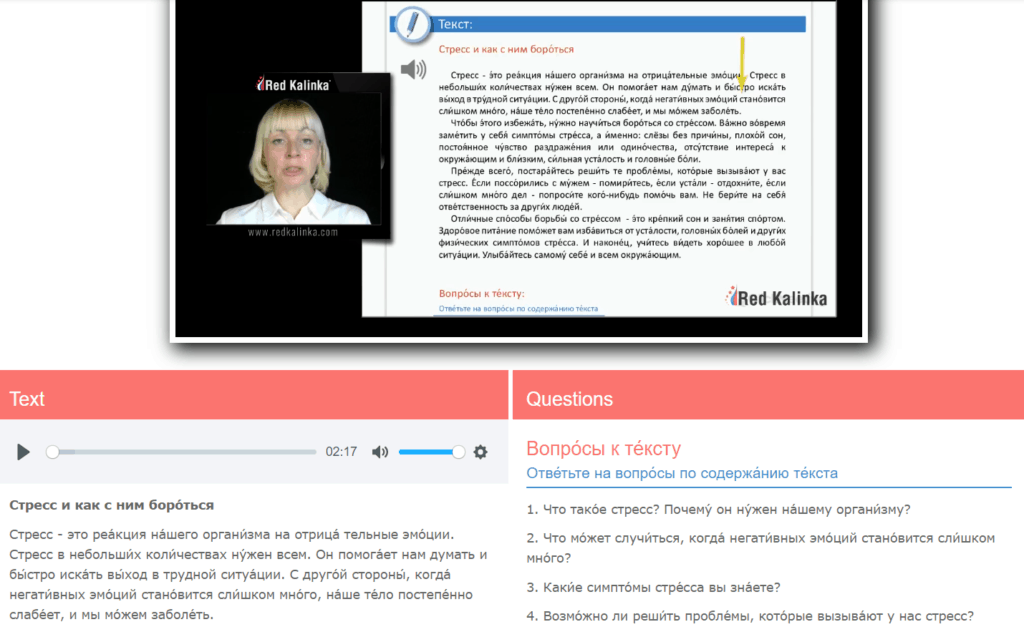
The in-depth analysis of grammar points and various words and phrases in Russian is also very thorough; throughout the course you get to practice your reading, writing and comprehension skills.
I haven’t seen any other course that does this as well as Sistema Kalinka. Most other courses end up neglecting the reading or writing parts.
In addition to this, you can always email your private tutor with any questions you may have and they’ll help you out when you get stuck.
However, one thing that isn’t really covered in the course is speaking.
You’re kind of left to yourself to pronounce the words you learn and say them out loud. If you’re interested in getting feedback on your pronunciation, you may be interested in using Speechling as a supplemental resource.
You can also sign up for one-to-one private lessons on Red Kalinka.
If you do that, before each scheduled lesson you’ll receive some learning materials and audio files for you to go through. As such, they are a separate feature to the Russian course, although I imagine that some of the content builds on what you have learned in the course.
While I can’t really comment on whether the one-to-one lessons are worth checking out, I do believe that the Russian Course is very well done and that it is probably unrivaled when it comes to teaching you Russian (a big claim, I know!).
Although the videos aren’t particularly inspiring to watch and the exercises look like they could have come out of a textbook, I do think that the lessons are very effective and will get you reading, writing and understanding Russian to an advanced intermediate level, if not higher.
While I normally favor more engaging, interactive and interesting courses, I think that if you really want to learn Russian then you can’t beat Red Kalinka.
Its serious approach is very thorough and it certainly bests other platforms such as Rocket Russian, Lingualift, and many others.
Plans and Prices
As mentioned, Red Kalinka has lots of different products to choose from. Some are aimed at getting you reading and writing Russian while others focus on your comprehension skills and getting you to speak the language.
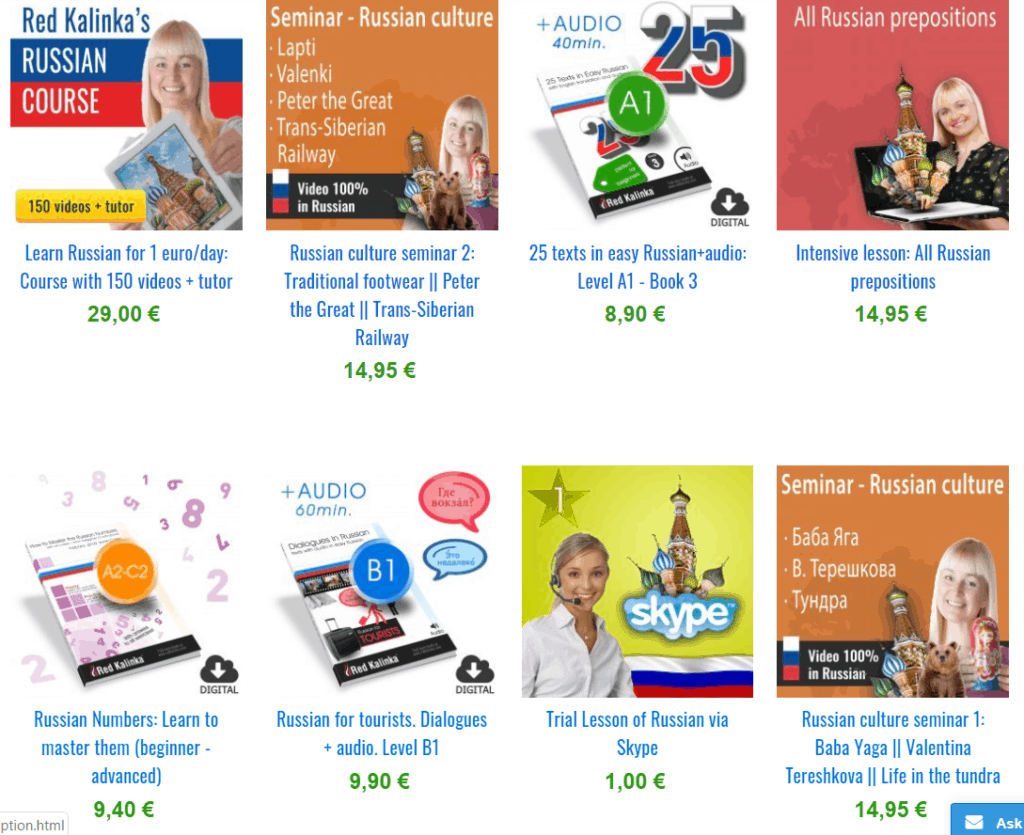
While I can’t comment much on the other products they offer, given the quality of their main course, I’d suspect those other products are also quite good.
The Sistema Kalinka Russian Course costs 29 euros a month. However, readers of All Language Resources can save 20% on the monthly subscription cost by signing up here.
This is the only subscription plan available although you can always cancel and receive your money back within the first seven days.
One area that it does fall short in, however, is when it comes to speaking practice, as it mostly gets you to repeat words and say them out loud to yourself.
This is where the one-to-one private lessons come in.
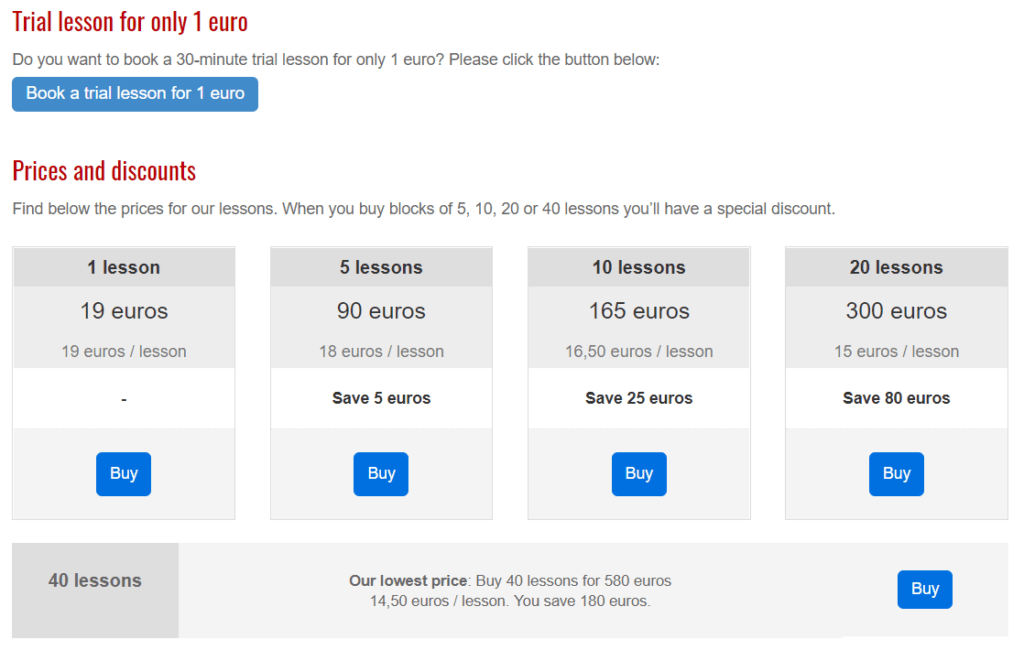
You can buy various bundles of Skype lessons, and before signing up for them there is a thirty-minute one euro trial which you can try out.
Otherwise, it works out at 19 euros for one lesson, 90 euros for five lessons, 165 euros for ten, 300 euros for twenty or 580 euros for forty!
Before each lesson, you are sent learning materials for you to go over. Throughout the fifty-minutes you’ll work through various grammar points, conversation topics and exercises while reading and conversation practice can also be included.
Those on a tighter budget may want to use italki for one-to-one lessons or finding language exchange partners as that will end up being a bit cheaper.
With its serious approach, I don’t think that the Sistema Kalinka Russian Course is suited to everyone. Casual learners may be better off with apps like Lingodeer, Babbel, or Duolingo.
But if you’re willing to put in the work, Red Kalinka offers a ton of value at an affordable price.
Extra Information
My biggest criticism of Sistema Kalinka is that it is not that fun or engaging to work through.
There are, however, plans in the pipeline to improve the course and add more interactive exercises as well as a feature that allows you to track your progress.
While I’m not entirely certain when this will take place, I imagine it would definitely improve the Russian Course as everything Red Kalinka seems to do is quite well-thought-out and comprehensive.
Final Thoughts
While I usually go for more engaging, interactive and entertaining courses, Red Kalinka’s Sistema Kalinka Russian Course appealed to me.
I really do think that it is a great option if you are interested in learning how to read, write and understand Russian as well as improve your knowledge of Russian vocabulary, grammar, and culture.
Although the content covered in the videos, PDFs, and exercises basically amounts to a slightly more engaging textbook, the amount of Russian used right from the start is very impressive and each lesson teaches you lots of useful words, phrases and grammar points.
In addition to this, there is a clear progression throughout the course and by the end of it, you’ll be listening to the teacher speak almost entirely in Russian.
With their well-designed and comprehensive lessons, Sistema Kalinka is easily the most thorough online Russian course I’ve tried.
Save 20% each month on a subscription to Sistema Kalinka by signing up through the link below.

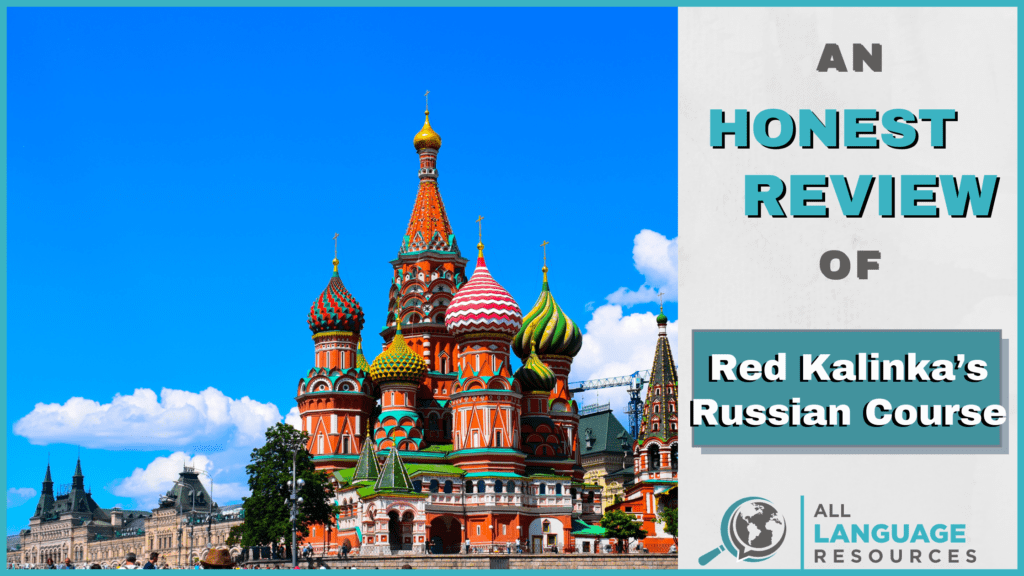
Having tried Busuu I have later on booked with RA (Russian Accelerator).
Busuu has one superb feature, which is the possibility to obtain help by native speakers. Sometimes this is very helpful and it usually hammers a point. At other times it can be kind of a kinder-garden, although the main kinder-garden feature, the “busuu-berries” has been dropped a while ago already.
The biggest and kind of fatal flaw is the fact, that one original version of the course probably has been translated electronically into other languages. So, a lot of things just don’t make sense and/or are not clear so that you have to use electronic translation into your language in order to get the gist of the Russian text examples!
The course is a bit overloaded and progressing (too) fast.
RA is explaining very well, but kind of progressing quite slowly and carefully avoids to stress the (American) learner with grammar, to a point when you just go looking elsewhere on order to find the answer you are looking for. Particularly true, if you are an “experienced learner”.
Well, you live and learn even learning a new language!